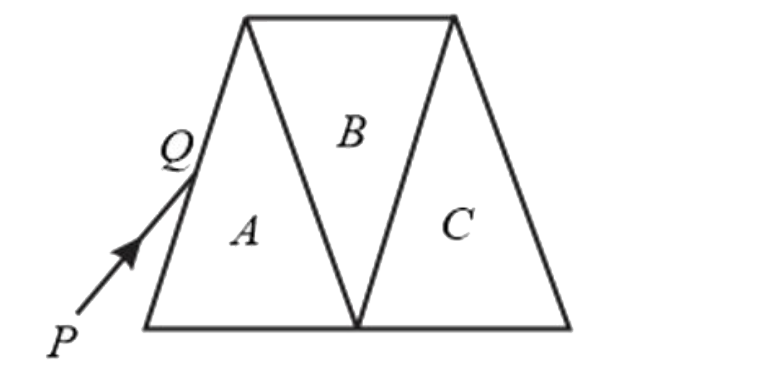A prism can produce a minmum deviation δ in a the beam. If three such prisms are combined, the minimum deviation that can be produced in this beam is
0
2δ
δ
3 delta
The correct Answer is:B
To solve the problem, we need to analyze the behavior of light passing through multiple prisms and how their minimum deviations interact. Here's a step-by-step solution:
Step 1: Understand the Minimum Deviation in a Single Prism
A single prism can produce a minimum deviation, denoted as δ, when light passes through it. This deviation is a characteristic of the prism's angle and the refractive index of the material.
Hint: Recall that the minimum deviation occurs when light enters and exits the prism symmetrically.
Step 2: Analyze the Effect of Multiple Prisms
When multiple prisms are combined, the light passing through them will experience deviations based on how each prism interacts with the light.
Hint: Consider how light behaves when it passes through multiple optical elements in sequence.
Step 3: Consider the Sequence of Prisms
Let’s denote the three prisms as Prism 1, Prism 2, and Prism 3. When light passes through these prisms:
- Prism 1 causes a deviation of δ.
- Prism 2, which is placed next, will cause the light to converge back to white light, effectively introducing a deviation of −δ (since it reverses the dispersion).
- Prism 3 will again cause a deviation of δ as it disperses the light once more.
Hint: Think about how the light is transformed by each prism in the sequence.
Step 4: Calculate the Net Deviation
Now, we can calculate the net deviation:
- Deviation from Prism 1: +δ
- Deviation from Prism 2: −δ
- Deviation from Prism 3: +δ
The net deviation can be calculated as follows:
Net Deviation=δ+(−δ)+δ=δ
Hint: Combine the deviations algebraically, paying attention to the signs.
Step 5: Conclusion
The minimum deviation that can be produced by the combination of three prisms is δ.
Final Answer: The correct option is δ (Option 3).
---
A single prism can produce a minimum deviation, denoted as δ, when light passes through it. This deviation is a characteristic of the prism's angle and the refractive index of the material.
When multiple prisms are combined, the light passing through them will experience deviations based on how each prism interacts with the light.
Let’s denote the three prisms as Prism 1, Prism 2, and Prism 3. When light passes through these prisms:
- Prism 1 causes a deviation of δ.
- Prism 2, which is placed next, will cause the light to converge back to white light, effectively introducing a deviation of −δ (since it reverses the dispersion).
- Prism 3 will again cause a deviation of δ as it disperses the light once more.
Now, we can calculate the net deviation:
- Deviation from Prism 1: +δ
- Deviation from Prism 2: −δ
- Deviation from Prism 3: +δ
Net Deviation=δ+(−δ)+δ=δ
The minimum deviation that can be produced by the combination of three prisms is δ.
Topper's Solved these Questions
- BOOK - HC VERMA ENGLISHCHAPTER - DISPERSION AND SPECTRAEXERCISE - Objective -25videos
DISPERSION AND SPECTRA
- BOOK - HC VERMA ENGLISHCHAPTER - DISPERSION AND SPECTRAEXERCISE - Exercises11videos
DISPERSION AND SPECTRA
- BOOK - HC VERMA ENGLISHCHAPTER - DISPERSION AND SPECTRAEXERCISE - Worked out Examples3videos
DISPERSION AND SPECTRA
- BOOK - HC VERMA ENGLISHCHAPTER - CAPACITORSEXERCISE - short answer7videos
CAPACITORS
- BOOK - HC VERMA ENGLISHCHAPTER - ELECTRIC CURRENT IN CONDUCTORSEXERCISE - questions for short answer17videos
ELECTRIC CURRENT IN CONDUCTORS
Similar Questions
In the minimum deviation position, the………. In the prism is……… to the base of the prism.
View SolutionA ray of light falling at an angle of 50∘ is refracted through a prism and suffers minimum deviation. The angle of the prism is 60∘. Find the angle of minimum deviation and refraction index of the material of the prism.
View SolutionThe deviation produced by a prism is
View SolutionAn equilateral prism produces a minimum deviation of 30∘. The angle of incidence is
View SolutionAngle of minimum deviation is equal to the angle prism A of an equilateral glass prism. The angle incidence at which minimum deviation will be obtained is
View SolutionIf minimum deviation = 30∘, then speed of light in shown prism will be
View SolutionIf the refracting angle of a prism is 60∘ and the minimum deviation is 30∘, then the angle of incidence is
View SolutionThe ray PQ shown in the figure , surface minimum deviation in an equilateral prism A. Two more identical prism B and C and of the same material as A are now placed in contact as. Show in the figure . If prism A produces a minimum deviation δm, the deviation produced by the combination of prisms A, B and C will be
 View Solution
View SolutionA thin prism of angle 6.0∘,ω'=0.07andμy'=1.50 is combined with another thin prism having ω=0.08andμy=1.60. The combination produces no deviation in the mean ray. (a) Find the angle of the second prism. (b) Find the net angular dispersion produced by the combination when a beam of white light passes through it. (c) If the prisms are similarly directed, what will be the deviation in the mean ray ? (d) Find the angular dispersion in the situation described in (c).
View SolutionThe angle of incidence for a ray of light at a refracting surface of a prism is 45∘. The angle of prism is 60∘. If the ray suffers minimum deviation through the prism, the angle of minimum deviation and refractive index of the material of the prism respectively, are :
View Solution

